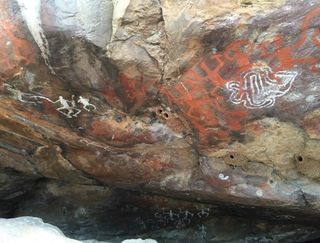This Man Was Killed by Brutal Boomerang Blow 800 Years Ago

When thrown properly, boomerangs can be lethal weapons. In fact, cave paintings in Australia show that they've been used as such for thousands of years, during hunting and war.
Now, scientists think they might have the remains of a boomerang-attack victim, with the discovery of an 800-year-old skeleton that has a long gash in its skull.
The bones were found eroding out of a riverbank in New South Wales' Toorale National Park two years ago. The skeleton — a male, likely between 25 and 35 years old when he died —was well preserved and appeared to have been carefully buried in a tightly flexed position. He was named "Kaakutja," a term from the local Baakantji people meaning "older brother."
Researchers found that Kaakutja ate crayfish and possum for his last meal, and that conflict was part of his lifestyle; he had two head injuries that had partially healed and fresh deadly wounds that had no signs of healing. [8 Grisly Archaeological Discoveries]
He had rib fractures and a wound to his upper arm. His skull was sliced down the right side of his face, from the frontal bone of his skull to his jaw, with the type of cut that's usually inflicted by a sharp-edged metal weapon. Radiocarbon dating, however, showed that Kaakutja died in the mid-13th century, 600 years before Europeans brought metal weapons to Australia.
For answers, the researchers, led by palaeoanthropologist Michael Westaway of Griffith University in Australia, turned to aboriginal weapons like stone axes and a type of wooden club known as a lil-lil.

Kaakutja's main head wound was about 6 inches (15 centimeters) long, meaning the weapon must have had a blade at least this length, the scientists reasoned. In their study, which is detailed in the October issue of the journal Antiquity, the team concluded that the sharp edge of a wooden boomerang most likely caused this lengthy cut. The researchers added, however, that they could not say for certain whether this was the fatal blow that killed Kaakutja. “Multiple wounds probably led to significant blood loss and eventual death,”they wrote.
Sign up for the Live Science daily newsletter now
Get the world’s most fascinating discoveries delivered straight to your inbox.
One ethnographic account from the early 20th century claims aboriginal Australians used a type of boomerang for fighting or hunting. It was bigger and heavier with a more open curve than the typical returning boomerang and "reminds one of the blade of a sabre and its inner edge is sharp and dangerous." The case of Kaakutja could attest to the lethal power of such a weapon.
"The nature and expression of trauma suggests that some edged weapons from traditional Aboriginal culture had the capacity to inflict injuries similar to those produced by edged metal weapons," the researchers wrote.
The case might offer archaeologists a rare chance to study conflict among aboriginal people that occurred before the arrival of Europeans. The authors of the study wrote that there is only one other documented case of fatal injuries found on a skeleton in Australia from this period —a man killed with stone-tipped spears 4,000 years ago, and found beneath a bus shelter in Sydney.
Kaakutja didn't appear to have any defensive injuries on his forearms. The authors of the study think he may have been killed in a surprise attack, perhaps while he was sleeping, or while he was holding a shield.
Original article on Live Science.

Most Popular


